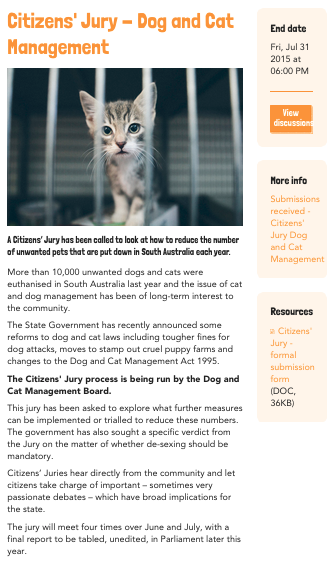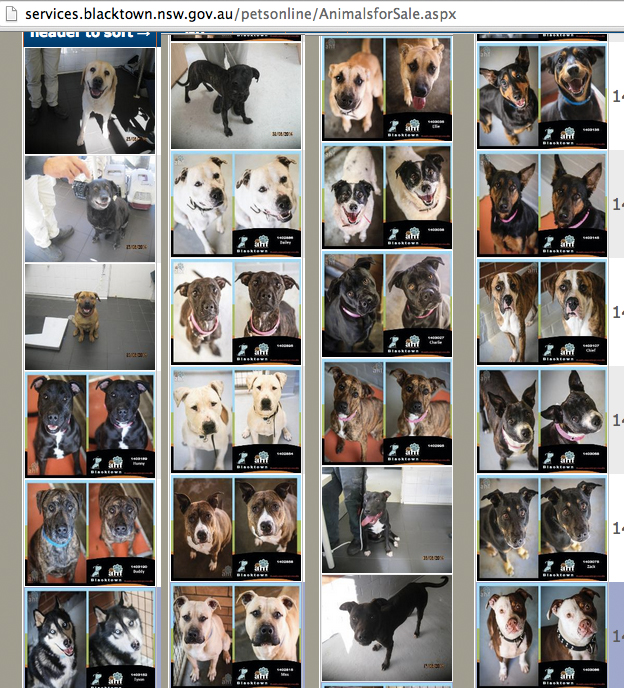My Say: Mandatory Desexing
(This is the last post in a four part series on dog and cat reforms in South Australia. See post one here, post two here, and post three here.)
 The YourSay website invites submissions to a citizen’s jury. While we could discuss the validity of allowing (quote) “32 ordinary South Australians” to decide on whether various animal species should undergo the medical procedure of a gonadectomy… Unfortunately, this process has already been decided on, and hence we must make a submission according to this format.
The YourSay website invites submissions to a citizen’s jury. While we could discuss the validity of allowing (quote) “32 ordinary South Australians” to decide on whether various animal species should undergo the medical procedure of a gonadectomy… Unfortunately, this process has already been decided on, and hence we must make a submission according to this format.
When accessing the site, you will need to download a word document to make a submission. It is only on this document do we get the date that submissions are due in by: Friday 10th July 2015
This form also asks the question:
Last year in South Australia over 10,000 unwanted dogs and cats were put down.
The State Government recently announced some reforms to dog and cat laws.
What further measures can we introduce or trial to reduce the number of unwanted pets?
While the downloaded word document doesn’t explicitly mention desexing, the site does with the comment:
The government has also sought a specific verdict from the Jury on the matter of whether de-sexing should be mandatory.
The form also specifies that the your submission should not be more than two pages, and yet asks for examples to be provided… It’s an impossibility to provide ample compelling evidence in these narrow frames.
However, my response (which you are, as always, welcome to use in shaping your own) is below:
I am adamantly opposed to mandatory desexing. The reasons for this opposition are:
Mandatory desexing has not been shown to reduce the incidence of euthanasia in animal shelters. In areas where it has been implemented, often there is a subsequent increase in the number of animals entering the facility, as people are financially unable to desex their pets and, to avoid risk of prosecution, they choose to relinquish them. Internationally this affect has been seen Los Angeles and, more locally, in Western Australia. Mandatory desexing has actually been demonstrated to increase euthanasia, and therefore should not be an option for South Australia on this basis alone.
However, mandatory desexing is a move that is rejected by the Australasian Veterinary Association (AVA). The AVA represents veterinarians across Australia, and so it would be sensible for policy makers to develop legislation that corresponds with statements made by this peak body. Additionally, it is anticipated that veterinarians would be responsible for performing desexings (mandatory or otherwise), and so their support is crucial for successful implementation of mandatory desexing. Considering that veterinarians have significant financial gains to be made from such a policy, yet choose to reject it is, is an indicator of the lack-of-support for mandatory desexing.
Finally, and crucially, there is evidence that desexing in dogs can pose some health risks to animals. These risks include:
- Increased incidence of some cancers (including mast cell tumours, hemangiosarcoma, lymphoma, osteosarcoma, and lymphosarcoma),
- Higher incidence of joint disorders (including hip dysplasia and cranial crucial ligament tears), and
- Increased incidence of behavioural problems (including reactivity, aggression, and anxiety, storm phobias).
Studies that indicate these problems have been published in peer-reviewed academic journals, illustrating that this is not ‘sensationalised’ content, but the results of real research on dog populations. Considering the available evidence, it seems immoral and contradictory to animal welfare goals to obligate pet owners to subject their animals to such risks.
As alternative means to reducing the number of unwanted pets, there are a number of approaches that could be trialled. The most obvious would be requiring improvements in reclaims. For many animals entering shelters, they have homes that want to get them home. Unfortunately, the large shelters in Australia are not proactive in listing impounded animals. This makes it difficult for owners to know where their pet is to bring them home. Further, if they do visit a facility to reclaim their pet, many times there are large fees that they are required to pay to get the impounded animal out. This is a barrier to individuals getting their pets home, while if they stay at the shelter they may be at risk of euthanasia. An additional barrier is poor opening times of this facility, meaning in many cases animals have to stay in the shelter longer due to their owner’s inability to access the facility. In summary, the procedure for individuals reclaiming animals needs to be improved by:
- Impound facilities clearly listing all impounded animals online.
- Legally enforceable guidelines regarding the scanning of microchips and the use of the information to find the owner.
- Fees and charges for the release of impounded animals being reduced, waived, or available on a payment plan.
- Impound facilities having opening times that make them highly accessible to the public.
Other changes that could be made at a shelter level to reduce euthanasia include:
- Oreo’s Law – the requirement that animals are not euthanised if there is any individual or group who is willing to take them.
- Mandated time for adoption – require facilities to offer all animals for adoption for a set period, perhaps 72 hours.
Finally, a big reason that animals end up in shelters is due to owner accommodation issues. This includes those who are renting, or fleeing their home due to violence. If we deal with human issues, people will be more likely to retain their pets. Changes that encourage landlords to permit pets, and providing temporary accommodation that allow pets, are important to prevent animals being relinquished to shelters.
In summary, suggestions for reducing shelter euthanasia include:
- Creating legislation that requires shelters to:
- Do more to assist reclaims,
- Allow adoptions for animals who have no choice but euthanasia, and
- Allow all animals to be available for adoption for a minimum period of time.
- And dealing with community issues surrounding owner accommodation issues.
Further reading:
“Just stop breeding until the pounds are empty”
Why would you NOT desex your dog???
Are you willing to be wrong about that?



